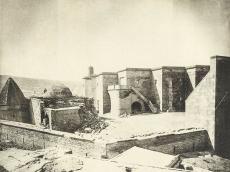|
|
TODAY.AZ / Society
Keygubad Mosque: Lost artifact of early Azerbaijani architecture
27 October 2022 [10:24] - TODAY.AZ

By Azernews
By Vugar Khalilov
What distinguishes Baku from Azerbaijan’s other ancient cities is its establishment as a religious center and a holy city since its foundation. The area surrounded by the fortress wall of the not-so-big Old City is abundant with religious architectural monuments - mosques, and tombs, as well as traces of churches and fire-worshipping temples that attract attention.
The site has been a meeting place for different religions throughout history. Well-known as the Land of Fire, Baku is famous for its fire temples built on natural gas sources, which made it a sacred religious hub for fire worshipers from different parts of the world.
Starting from the early VII century, Islam rapidly spread in many Azerbaijani cities, including Baku, a significant venue for fire worshipers, where mosques were traditionally erected on the remains of ancient temples.
The historical-architectural monuments reflecting the religious life of the Old City once had a significant impact on social development. Thus, mosques significantly contributed to the advancement of science and education during the Middle Ages in Azerbaijan.
There are several historical architectural ruins across the Shirvanshahs Palace Complex in the Old City, one of the finest examples of Azerbaijan's medieval architecture and the residence of the Shirvan rulers.
The Shirvanshahs' realm, the largest feudal monarchy in northeast Azerbaijan, ruled from IX to XVI centuries. The powerful and erudite rulers, such as Akhsitan, Fariburz, Sheikh Ibrahim, and Khalilullah were not only skilled warriors and diplomats but also patrons of the arts, particularly architecture. As a result, Baku, the state's new capital after the Shamakhi earthquake of 1192, gained fame for its architecture.
The Keygubad Mosque, a mosque-madrasa that is a component of the Shirvanshahs royal complex, is located next to philosopher Seyid Yahya Bakuvi's (1410-1462) tomb. There was a small corridor in the mosque, in front of the rectangular prayer hall, and the tomb was situated in the southernmost section of the building. Some historians claim that I Keygubad ibn II Farrukhzad, one of Shirvan's well-known kings, who ruled the country from 1317 to 1348, ordered the construction of the mosque-madrasa.
Those who had visited the mosque described it as a square in design with four columns supporting the dome. The main arch and the other arches were connected. There is disagreement on the building's exact construction date and purpose. The mosque, according to some researchers, was erected over the remains of an earlier structure.
Historians claim that philosopher Seyid Yahya Bakuvi taught the Shirvanshah family's children at this mosque-madrasa. The mosque was burned down and destroyed on March 31, 1918, during the genocide of Azerbaijanis by barbaric Armenians. The mosque was only partially repaired in 2005, based on the measurements recorded by the architect Ismayil Bay Nabioglu before the fire (1918-1920).
In his book, entitled "Icharishahar," Kamil Farhadoglu claims that the Keygubad mosque was a mosque-madrasa structure close to the Darvish tomb. Abbasgulu Aga Bakikhanov (1794-1847), on the other hand, stated of Bakuvi's teaching and worship at the mosque: "The cell where he worshipped, the school where he worked, and his grave are there - in the mosque."
The mosque had a tiny passageway in front of the rectangular prayer hall. Four columns supported the dome in the middle of the room. The vestibule linked the gateway to the mosque's rectangular floor layout. On the southern wall of the prayer hall, there was a mihrab (niche) next to the mausoleum's entrance.
The corners of the hall's columns were converted into tiny, enclosed chambers with clapboards covering their tops, and the inside had a cruciform-domed structure.
The mosque's volume-spatial composition, which is linked to Seyid Yahya Bakuvi's tomb, acquired a special plasticity of forms thanks to the architectural interpretation of the distinctive order, providing the columns with a unique character. This is especially evident through the precision of geometric lines and architectural elements.
It is impossible to determine whether the mosque or the tomb was constructed first, nevertheless, it is clear that there is no natural connection between the structures. Even if the exact date of the transformation is unknown, it is obvious that one of these buildings was attached to the other one.
The middle courtyard, which includes the tomb and the Keygubad mosque, occupies a neutral space in the Shirvanshahs' royal complex and serves to prepare visitors for their encounter with the Shirvanshahs mausoleum, the Shah Mosque, and the Palace bath located in the lower courtyard.
Currently, only the remains of the foundation and a few arches have survived from the Keygubad Mosque in the southern part of the lower courtyard of the Shirvanshahs Palace.
URL: http://www.today.az/news/society/227345.html
 Print version
Print version
Connect with us. Get latest news and updates.
See Also
- 19 April 2024 [17:36]
Baku French High School discloses reason for suspension of activity - 19 April 2024 [13:36]
Heydar Aliyev-International Education Grant Program announced for 2024-2025 academic year - 18 April 2024 [20:10]
Ombudsman representatives attend Environmental Security & Green World Conference - 17 April 2024 [16:47]
OSCE acting chairperson to visit Azerbaijan - 17 April 2024 [15:34]
Employability Week held at ADA University - 17 April 2024 [14:56]
Azerbaijan to increase number of high schools, gymnasiums in all regions, says Minister - 16 April 2024 [14:53]
MoU on establishment of Turkiye-Azerbaijan University approved - 16 April 2024 [12:17]
Opening ceremony of "Caspian Basin Studies" program held at ADA University - 15 April 2024 [12:55]
Heydar Aliyev Foundation takes over former footballer Vadim Vasilyev's treatment - 15 April 2024 [10:00]
Earthquake hits Azerbaijan's Imishli district
Most Popular
 EU acknowledges strategic significance of Baku International Sea Trade Port in Middle Corridor
EU acknowledges strategic significance of Baku International Sea Trade Port in Middle Corridor
 Weapons & ammunition discovered in Khankendi
Weapons & ammunition discovered in Khankendi
 South Korea conducts live-fire exercises near borders of DPRK
South Korea conducts live-fire exercises near borders of DPRK
 Navigating challenges in Azerbaijan's trade turnover amidst global uncertainties
Navigating challenges in Azerbaijan's trade turnover amidst global uncertainties
 TikTok closed in Kyrgyzstan
TikTok closed in Kyrgyzstan
 Azerbaijan's AccessBank joins UN Global Compact
Azerbaijan's AccessBank joins UN Global Compact
 Rising fuel expenses signals economic challenges for Azerbaijan
Rising fuel expenses signals economic challenges for Azerbaijan
